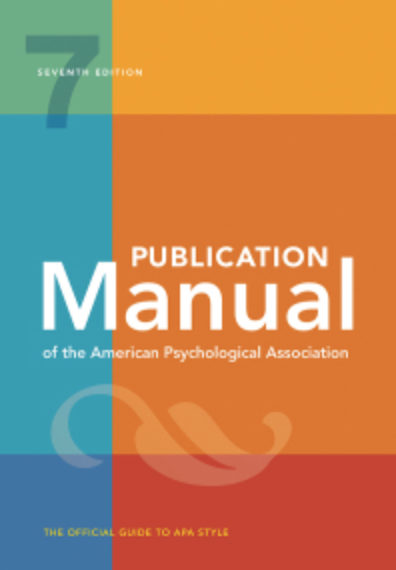Compiled by Denise Cummings Clay
Conditions of Use:

Unless otherwise noted, this work is licensed under a Creative Commons Attribution-NonCommercial 4.0 International License.
You will often use sources for academic writing, and it’s important to know how to responsibly cite and integrate those sources into your own writing. APA format provides guidelines and structures for citing those sources in a way that helps you avoid plagiarism and give proper credit to your sources.
APA stands for the American Psychological Association. Most papers that use APA formatting and citation style are those written in the Social Sciences: Psychology, History, Political Science, Economics, Geography, and Sociology.
In addition to the Publication Manual of the American Psychological Association, 7th edition, the APA maintains its own website with multiple examples of how to format your paper and cite your sources. If you’re unable to find the answer to your question here, check the APA Manual 7th edition or the APA website.

Papers constructed according to APA guidelines generally include the following elements:
In most cases, each of these elements will begin on a separate page, and it is important to note that not all academic papers will include all of these elements. . .
The APA style demos in this section will provide you with more information regarding APA basic formatting, in-text citations, and the references list.
The above text and most of the following videos and links are provided by the Excelsior Online Write Lab (OWL).
APA citations follow specific conventions that distinguish them from other styles.
When listing the source of information you are using in your paper, list the last name of the author (without their initials), followed by a comma, and then the year of publication. When referring to the author(s) directly in the text (also called a narrative citation), then list only the year (and page number, if needed for a direct quote).
Examples of the two types of in-text citations:
One scholar argued that it is impossible to measure social class (Calvert, 1982).
Calvert (1982) argued that it is impossible to measure social class.
This video will show you what in-text citations should look like and explain why you must use them.
Every cited source from your essay, with the exception of personal communications, should appear in your References page, which comes at the end of the essay.
The References page must conform to the following rules:
Click on the following pages to view information on how to create a specific reference entry for your source type.
In this video on APA format, you’ll see a sample references list with some tips on creating a references list of your own.
Once you review the different aspects of APA formatting, you may find that it takes you awhile to remember everything you need to do. Referring back to helpful resources here can help, but a guide of the key components of APA can provide important reminders and support. When you have your paper in order, it’s a good idea to review with the guide below.
For the tutorial below, use the right arrow at the bottom to advance to the next slide.
After completing this activity, you may download or print a completion report that summarizes your results. To save a PDF copy of the report, click below and follow instructions for your browser.
For the tutorial below, use the right arrow at the bottom to advance to the next slide.
Scholarly vs. Popular Sources. Authored by: URILibraries. Located at: https://youtu.be/KD0ywd8QfaM License: CC BY 4.0.
APA Overview Seventh Edition. Authored by: Excelsior Online Writing Lab (OWL). Located at: https://owl.excelsior.edu/citation-and-documentation/apa-style/ License: CC BY 4.0.
APA 7 Student Paper. Authored by: The OWL Purdue. Located at: https://owl.purdue.edu/owl/research_and_citation/apa_style/apa_formatting_and_style_guide/documents/20200128APA7StudPaper.pdf License: All Rights Reserved.
APA In-Text Citations Seventh Edition. Authored by: Excelsior Online Writing Lab (OWL). Located at: https://owl.excelsior.edu/citation-and-documentation/apa-style/apa-in-text-citations/ License: CC BY 4.0.
APA References Seventh Edition. Authored by: Excelsior Online Writing Lab (OWL). Located at: https://owl.excelsior.edu/citation-and-documentation/apa-style/apa-references/ License: CC BY 4.0.
A Quick Guide to-APA Citation 7th Edition. Authored by: Jana Porter and Maria Bagshaw. Located at: https://drive.google.com/file/d/13pCKRGAJBQjXJr2wa7Z-S8s70hOu2xQe/view?usp=sharing License: CC BY 4.0.
APA Formatting Guide Seventh Edition. Authored by: Excelsior Online Writing Lab (OWL). Located at: https://owl.excelsior.edu/citation-and-documentation/apa-style/apa-formatting-guide/ License: CC BY 4.0.
APA Checklist Seventh Edition. Authored by: Excelsior Online Writing Lab (OWL). Located at: https://owl.excelsior.edu/citation-and-documentation/apa-style/apa-formatting-guide/ License: CC BY 4.0.
APA Activity Seventh Edition. Authored by: Excelsior Online Writing Lab (OWL). Located at: https://owl.excelsior.edu/citation-and-documentation/apa-style/apa-activity/ License: CC BY 4.0.
Appendix C: The Reflective Practitioner, Educational Psychology. Authored by: Kelvin Seifert and Rosemary Sutton. Located at: https://dl.dropboxusercontent.com/u/31779972/Educational%20Psychology.pdf Project: Global Text. License: CC BY: Attribution
Library Info and Research Help | reflibrarian@hostos.cuny.edu (718) 518-4215
Loans or Fines | circ@hostos.cuny.edu (718) 518-4222
475 Grand Concourse (A Building), Room 308, Bronx, NY 10451
